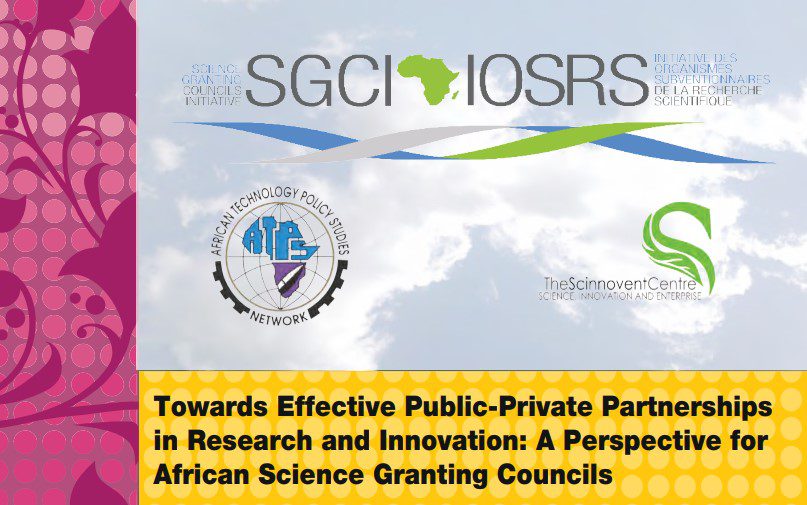This study investigates the evolving landscape of public-private partnerships (PPPs) in research and innovation (R&I) across sub-Saharan Africa. It focuses on the role of Science Granting Councils (SGCs). Drawing from…
This study investigates the evolving landscape of public-private partnerships (PPPs) in research and innovation (R&I) across sub-Saharan Africa. It focuses on the role of Science Granting Councils (SGCs). Drawing from literature reviews, international case studies, surveys, and interviews with African stakeholders, the paper uncovers how institutional, economic, and cultural factors shape PPPs.

Background of study on public-private partnerships
Public-private partnerships in R&I have become a pivotal strategy in global innovation policy. In Africa, they are gaining traction as mechanisms to bridge knowledge gaps, stimulate private sector engagement, and enhance the impact of science, technology, and innovation (STI) on development. However, unlike in the Global North, where PPPs aim to push the technological frontier, African partnerships often emerge episodically in response to resource constraints and institutional gaps.
While most African countries have adopted STI policies and are parties to regional frameworks like the Science, Technology, and Innovation Strategy for Africa (STISA-2024), significant disparities remain in institutional capacity and investment levels. Many SGCs are underfunded and underleveraged despite their critical role in coordinating national research agendas and fostering stakeholder collaboration.
Methodology
The research employed a triangulated approach that included:
- A literature review of STI and innovation systems theory.
- Desk-based analysis of international and African PPP case studies.
- Surveys and interviews with 43 respondents across 33 organisations in 18 countries, including SGCs, policy institutions, and private sector actors.
Countries examined included members of the SGCI (e.g., Kenya, Ghana, Uganda) and others like Nigeria and South Africa, providing comparative insights.
Key Findings
Typologies and Trends
PPPs in R&I vary widely in structure and intent. They range from supply partnerships optimising resource use to product development consortia and early-stage innovation platforms. However, in Africa, they are often informal, geographically constrained, and driven by donor funding or short-term needs rather than long-term strategic planning.
Role of SGCs
SGCs are central to fostering PPPs but face structural challenges. Many councils operate in isolation, lack incentives to engage the private sector, and are often perceived as bureaucratic rather than catalytic actors. There is a need for more explicit mandates, better coordination mechanisms, and targeted incentives to drive cross-sector collaboration.
Institutional and Cultural Barriers
- Legal frameworks for managing intellectual property and PPP contracts are underdeveloped.
- Geographical proximity is critical; most partnerships cluster around urban centres or research hubs.
- Relational distance between universities and firms hinders collaboration, particularly in SMEs.
- Informal knowledge systems dominate but are poorly integrated into formal innovation policy.
International Lessons
The study draws lessons from the EU’s Horizon 2020 programme, India’s TIFAC model, and the BD-PEPFAR partnership in the US/SSA context. These models underscore the importance of:
- Long-term, legally binding contracts.
- Clearly defined roles and performance indicators.
- Strategic alignment with national development goals.
- Strong intermediary institutions to broker partnerships.
Policy Recommendations
To enhance the effectiveness of PPPs in African R&I ecosystems, the study recommends:
- Institutional Reforms: Strengthen the capacity and mandate of SGCs to design, manage, and monitor PPPs.
- Enabling Environments: Develop legal and regulatory frameworks for intellectual property, contract enforcement, and dispute resolution.
- Private Sector Incentives: Offer fiscal incentives and co-funding opportunities to stimulate private investment in R&I.
- Capacity Building: Invest in training for SGCs, universities, and private firms to manage partnerships effectively.
- Regional Integration: Promote cross-border research platforms and networks to pool resources and expertise.
Summary
Public-private partnerships promise to advance Africa’s innovation agenda, but they must be grounded in the realities of local systems and supported by strong, adaptable institutions. Science Granting Councils, as pivotal actors in national innovation systems, require strategic empowerment to facilitate sustainable, inclusive, and impactful research partnerships.
Themes
The SGCI aims to strengthen the capacities of these SGCs to support research and evidence-based policies that will contribute to economic and social development.

